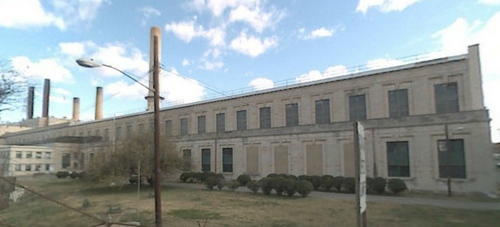Pepco Benning Road site is perfect for the NFL or FBI
The FBI is looking to move its headquarters, and some DC leaders are trying to woo the Redskins back to the District. The soon-to-be-shuttered Pepco power plant would make an ideal site for either one.
The FBI requires 55 acres surrounded by a large security “moat,” which makes it impossible to locate downtown and undesirable in most any DC neighborhood. Prince George’s and Fairfax counties are both vying to make one of their Metro stations the future home for the FBI.
As the map above shows, Pepco’s main parcel (outlined in black) covers approximately 80 acres. There is plenty of space here for a new FBI headquarters. This could be an option if DC truly wanted to fight to keep the FBI here.
There would be other obstacles, though. A Senate committee required that the GSA place the FBI within 2½ miles of the Beltway, and within 2 miles of a Metro station. The Pepco site is less than ½ mile from the Minnesota Avenue Metro, but more than 5 miles from the Beltway. It is, however, adjacent to a freeway that directly connects to the Beltway in two places, but Congress would need to amend the requirement to make the Pepco site eligible.
FedEx Field, the current home of the Redskins, and its adjacent parking lots encompass approximately 160 acres. A National Park Service maintenance facility and land used as a trash-transfer station lie immediately north of the power plant. These could be combined with the plant site, creating a 90-acre parcel (outlined in red).
While this is significantly smaller than the area currently used by the Redskins, it’s not much smaller than the approximately 95 acres of RFK Stadium and its adjacent parking lots, which the Redskins used for decades (when the team actually won multiple championships). Plus, a new stadium could take up less space by replacing the massive asphalt deserts that surround RFK and FedEx Field with more compact parking decks while still leaving some surface space for tailgating.

The west facade of the power plant. Imagine incorporating this into a new stadium; would you be ready to watch football at “The Powerplant”? Image from Google Maps.
The Pepco plant abuts a freeway, two Metrorail lines, a major street that provides direct access to downtown, and eventually, a streetcar line which will run along that street. Bicycle infrastructure in the form of trails and Capital Bikeshare stations are being added adjacent to the site; the Anacostia River trails are already close by. An infill Metrorail station could be built at the western end of the parcel, serving a stadium or a headquarters building as well as the River Terrace neighborhood to the south.
A serious obstacle with this site is that building anything first requires environmental remediation. While that might delay any construction there, Pepco and the District Department of the Environment have reached a preliminary agreement on site cleanup (more here and here (PDFs)). Planning for an actual use for the site could help make cleanup a higher priority for all parties involved.
A football stadium or FBI headquarters building would not foster good urbanism, but this site is already cut off from the neighborhoods to the east by the freeway, while the highway-like Benning Road and the Metrorail tracks form a formidable barrier to the south. Parkside, the neighborhood to the north, is not yet fully developed, and the Anacostia River lies directly to the west.
Administration officials are actively negotiating with the Redskins about putting a practice facility at Reservation 13, on the western side of the Anacostia. Unlike the Pepco site, this area can directly connect to the adjacent neighborhood if DC extends the street grid, as is planned.
If the District’s leadership continues to insist on bringing the Redskins back, the Pepco would make more sense in the long run than Reservation 13. If they believe we shouldn’t let the FBI walk away from DC, this could be a location worth looking into. In addition, there could be many other uses for this site, from adaptive reuse of the plant itself, to light industry (perhaps renewable energy generation?), a unique mixed-use neighborhood, or expanded parkland.
The District shouldn’t wait to seriously plan for the reuse of this valuable piece of riverfront property, but will city leaders be able to pursue a use that’s creative?

